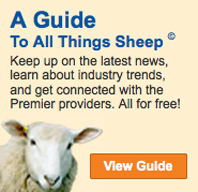
NEW! FENCES THAT WORK CATALOG
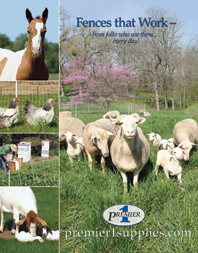 New!
New!
2014 Fence Booklet
Look for it in your mailbox the week of March 17. It includes, along with our standard products, the following new items:
VersaNet® Plus 9/20/3
Less distance (6.8 ft) between line posts than VersaNet® 9/20/3 (11.5 ft). The extra posts reduce sagging between posts and enables the net to adapt to curves, hills and dips.
Folks who like fences to look neat and tidy almost always prefer our “Plus” nets whatever the height.
VersaNet® Plus 12/60/3
This is a “Stops Nearly Everything” net. 60" (5 ft) tall to stop large and agile animals like deer, elk, bears, dogs, coyotes and livestock. Why use VersaNet® Plus 60 instead of PermaNet, VersaNet 30 or Deer QuikFence?
HotShock® & IntelliShock® Energizers
(Expected mid-April 2014.)
Low cost, new design! 0.5, 1, 2 and 3 joule units that use either battery or plug-in power. IntelliShock DC units are variable draw—that means they use less energy when the fence is clean, thus increasing battery life and reducing cost.
Insulators
| • |
Corner Roller—Prevents conductors from slipping off. Smooth roller prevents wear on conductors. Safer—plastic pin breaks if a horse crashes into fence. |
| • |
Double Pigtail Offset—Holds conductors on opposite sides of wooden post. For use with rope and narrow tape. Tolerates moderate up/down strain. |
Stainless Steel Spring Gate
New stainless steel option. This gate is popular and effective. It fully retracts when expanded. Uncoiled spring measures 16 ft.
PREMIER NETTING
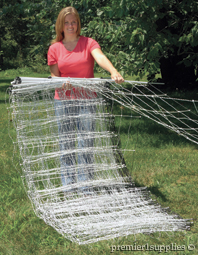 Premier is the source of 80% of the USA's electric netting. And we're the world leader for new netting designs and uses!
Premier is the source of 80% of the USA's electric netting. And we're the world leader for new netting designs and uses!
Why Premier “knows” netting…
| • |
We’ve used it for 44 years (since 1970)—longer than anyone in the US. |
| • |
It’s in use 24/7 at Premier to fence sheep, goats, poultry and dogs in—and to fence deer, coyotes and stray dogs out. |
| • |
We talk daily to netting users nationwide—who let us know what they like and/or dislike; when it works and when and why it doesn’t. |
| • |
View our Netting Comparison Chart to compare all of our nets. |
We have 3 netting videos available:
PREMIER ENERGIZERS
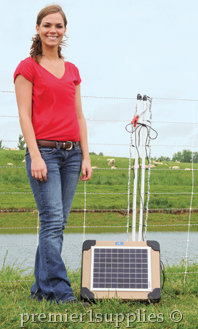
PRS units offer more released joules than most farmstore solar units. That means more fence can be electrified with a PRS.
PRS Solar Energizers
Which unit is right for you?
The size, in pulse energy output (range from .5 joule to 2 joules), depends almost entirely on the weed contact that will occur and the length of the fence.
Contact Premier or call 800-282-6631 to speak with one of our fence consultants to help you determine the best energizer for your needs. We have a unique 2-year rapid replacement warranty on all of our energizers.
You can also view our energizer comparison charts online or in Premier's fencing catalog to help in choosing an energizer.
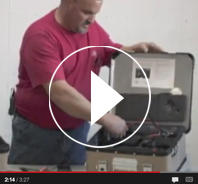
Fencing season is here. You'll find our video above on "How to get your PRS Solar Energizer ready for fencing season" helpful, with instructions and tips the folks at Premier have learned by experience.
|
 |
 |
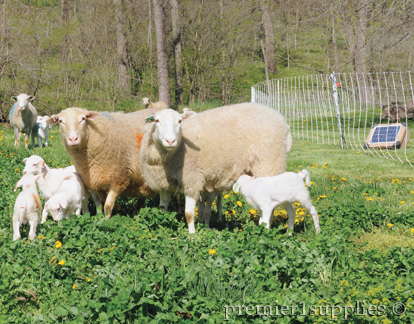
ElectroNet® Plus used to subdivide a rolling pasture (more so than it seems in this photo). "Plus" nets have reduced distance between posts, allowing this net option to better adapt and adjust to slopes, curves and dips without sagging. Shown is our Premier PRS Solar Energizer, which is electrifying the fence.
Before you buy or build a fence
Q. What is the fence’s location? Is it flat? Or does it go over hills and ditches and around curves? Is it covered with brush, trees or open grass? Are the soils rocky, very soft, sandy or firm?
A. The optimum fence design often hinges on answers to these questions.
Q. Do the animals know the fence?
A. Local animals and wildlife get to “know” a fence by appearance, location and “pain memory.” If it’s a strong or painful fence they avoid it. On the other hand new animals just off a truck often charge into permanent fences and straight through temporary or semi-permanent fences. That’s why strong, tall, visible permanent fences are essential for corrals and feedlots. Temporary fences that are not physically strong pose the greatest risk of escape to newly acquired animals. It pays to train them to it inside of a permanent fence.
Q. What specific animals need to be fenced in or out?
A. Always design and build for the most difficult species. Rules of thumb:
| • |
Most sheep and goat fences will stop cattle and horses. The inverse is not always true. |
| • |
Fencing adult males (bulls, rams, stallions, billies) in/out during breeding season requires taller fences with closer wire/strand spacing and more powerful electric pulses (in joules, not volts). |
| • |
Fences for mixed sizes (ewes with lambs, etc.) need more strands than uniform animal groups. |
| • |
Certain breeds need better fences (e.g. flighty Romanov sheep, tall Columbia sheep, Chianina cattle). |
Q. Should you energize the fence?
A. It pays to do this. Why?
| • |
A “hot” strand has a “zone of pain.” So fewer strands are needed if one is energized. Both the material and the labor to install is reduced. |
| • |
Energized fences last longer and require less maintenance—because animals do not crowd, rub or scratch on them. So the fence wires (including wires that are not energized) require less tension to do their job. And braces and corner posts will last longer. |
| • |
Animals are more surely contained or excluded during breeding and weaning. |
Q. How keen will animals be to breach the fence line?
A. Build for the worst-case situation (if you can afford to do so).
Some situations that require more secure fences:
| • |
Hunger. Starved animals will eventually challenge most fences |
| • |
Weaning. Strong physical barriers are needed. |
| • |
Breeding. Libido induces all creatures to challenge rules and especially fences. |
| • |
Boredom. Animals in corrals, stalls and lots crave any “entertainment” or activity. |
| • |
Gateways and handling yards. Animals often push each other into fences when being moved. |
| • |
Fear and fright. Predators or loud noises can cause “prey” species (e.g. horses, goats, turkeys) to run in terror straight into, under, over or through any fence, no matter what fence design (netting, high-tensile or woven wire). |
FENCE OPTIONS
Temporary…
moved daily or weekly
Temporary or portable fences are quick to install and remove.
The fence strands (whether single, multiple or a mesh/netting, properly electrified) require only hand-tensioning, thus eliminating the need for large end and corner posts.
(see photo at right) ElectroNet® 9/35/12 is Premier's original netting. It easily goes up and down hills, across creeks, around corners and across flat plains. Add support posts at corners and high/low points in fence line to reduce strain on net.
Semi-permanent…
moved once per season
Can be an interim barrier until a more permanent fence is installed. This allows folks to field-test fence and gate locations to see what works best.
Usually consists of electrified net or multiple electrified strands under low tension—supported by stronger/thicker posts than temporary fences.
(see photo at right) 3-strand fence supported by Premier's white PigTail step-in post and PigTail clips. We have found this post to be easier to use than most plastic step-in posts—and they don't break.
Permanent…
never moved
For boundary and subdivision fences for land that’s owned by the user—and whose usage is not likely to change!
Requires strong wood, steel or fiberglass posts that support high-tensile wires, woven wire, rope or wide tape—of which one or more strands are electrified. More reliable than other options but more expensive to install. May require a professional installer.
(see photo at right) Hi-Tensile smooth wires with optional offset wires on all "grazed" sides.
MINIMIZE FEED COSTS AND INCREASE PROFITS
Managing pastures for sheep
By Susan Schoenian, Sheep 101
The pasture resource is often the most neglected part of the sheep enterprise, yet it usually provides the majority of nutrients to the stock. Well-managed pastures that are properly grazed have the potential to minimize feed costs and increase profits. Pasture is the most natural diet for sheep and other ruminant animals. Though pasture is not without its own risks, fewer digestive problems are usually encountered among grazing sheep and lambs.
Pasture plants
A pasture can be comprised of many different kinds of plants. Which species to plant depends upon the purpose of the pasture, the climate, and soil type. Soil survey maps can help with the latter. The best pastures usually contain a mixture of grasses and legumes. Selecting one or more grass and legume species is usually preferable to commercial pasture mixes which may contain plant species which are not adapted.
Cool season grasses
Cool season grasses form the basis of most sheep pastures. Cool season grasses are annual or perennial plants that begin growth during the fall or winter and grow to spring or early summer. Cool season grasses are not damaged by sub-freezing temperatures. However, they go dormant during hot weather. Common cool season grasses include orchardgrass, Kentucky bluegrass, tall fescue, timothy, reed canarygrass, ryegrass, brome grasses, and wheat grasses.
Tall fescue
Tall fescue is the most important cool season grass in the United States. Most tall fescue is infected with a fungal endophyte that reduces performance in grazing animals and causes reproductive problems in horses. Sheep appear to be less affected by the endophyte than cattle and horses. Animal performance is superior on endophtye-free fescue, but plant persistance suffers. MaxQ™ tall fescue contains a non-toxic endophyte which improves animal performance while maintaining plant performance.
Tall fescue is the most desirable grass to stockpile for late fall and winter grazing. Unlike the summer forage, fall-saved fescue is palatable and high in digestibility. Forage quality losses after frost are less for fescue than other forages. Endophyte toxicity of stockpiled fescue declines with time.
Legumes
Legume plants are known their ability to fix atmospheric nitrogen. Legumes have a higher protein content than grasses. They fall into two classes: forage and grain. Forage legumes include alfalfa, clovers, birdsfoot trefoil, lespedezas, and vetch. Grain legumes include beans, peas, lupins, kudzu, and peanuts. Pasture legumes improve summer pasture productivity.
Legume pastures (alfalfa and clover) are a common cause of bloat. The phytoestrogens contained in some pasture legumes (e.g. red clover) can cause a decline in ewe fertility.
Sericea lespedeza
The high tannin content of sericea lespedeza gives it an “anthelmintic-like” effect. Fecal egg counts tend to be lower among small ruminants grazing sericea lespedeza pastures, as adult worms lay fewer eggs and the eggs that are produced have reduced hatching ability. Though it shows great promise for helping to control internal parasites in sheep and goats, sericea lespedeza is classified as a noxious weed in some states.
Warm season grasses
Warm season grasses are annual or perennial plants that begin growth during the spring, and grow to summer or fall until frost. Common warm season grasses include bahiagrass, bermuda grass, crabgrass, eastern gamagrass, big bluestem, indiangrass, switchgrass, sudangrass, and pearl millet. Most native grasses are warm season grasses. Sheep have generally not performed as well on warm season grasses as cattle.
Annuals
An annual is a plant that completes its life cycle in one year. Annuals must be planted every year in order to produce forage for livestock feed. Summer annuals complete their life cycle between spring and fall. Summer annuals include crabgrass, pearl millet, sorghum, sudangrass, and sorghum x sudangrass. Winter annuals complete their life cycle between fall and spring. Winter annuals include wheat, barley, winter oats, rye, and triticale (rye x wheat).
Brassicas
Brassicas are annual crops which can be grazed by sheep. They include rape, kale, swede, and turnips. They are most commonly used to extend the grazing season. Performance on brassicas is improved if dry hay is offered. Lamb performance on brassicas has varied.
Small grains
When properly managed, small grain crops can be used for grazing by sheep and other livestock. Small grains can provide excellent pasture in the fall and early spring. The effect of livestock grazing on small grain yields ranges from yield reductions to increases in yield.
Read More »
|
|